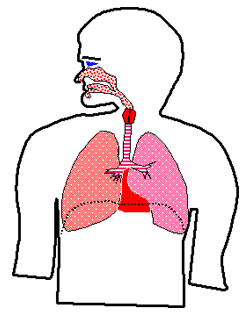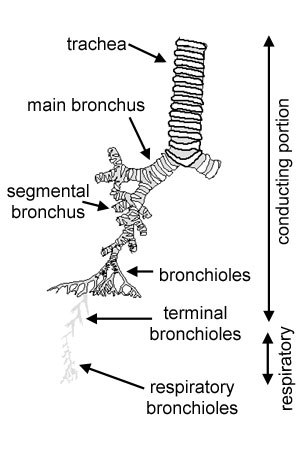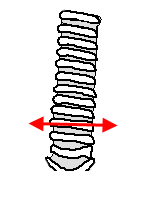Basic structure and function

This diagram shows the respiratory system. It can be split into two major components:
1. Conducting portion
The main function of the conducting system is to 'condition' the inspired air:
Air is conditioned by being: humidified (by serous and mucous secretions) warmed (by underlying blood vessels) and
filtered (by particles being trapped in mucous secretions, and transported towards the throat, where the mucous is swallowed).
The upper regions of the respiratory system (in the nasal passages) are covered with respiratory mucosa, and in some regions, olfactory
mucosa.
Find out more about the conducting portion.
2. Respiratory portion

The interphase for passive exchange of gases between the atmosphere and blood.
This diagram shows the components of the respiratory system.
The conduction portion is made up of:
- nasal cavities, nasopharynx, larynx, trachea, bronchii and bronchioles
The respiratory portion is made up of
- respiratory bronchioles, alveolar ducts, alveolar sacs and alveoli.
Find out more about the respiratory portion.
This shows across section through the trachea. Can you identify the mucosa, submucosa and cartilage layers?
Basic Structure of the Respiratory System

The respiratory system consists of four main layers:
- the respiratory mucosa (epithelium and supporting lamina propria)
- Submuscosa
- Cartilage and/or muscle layer
- Adventitia
The components of these layers in different regions of the respiratory system, and are related to the functions of each component of the respiratory system.
One example is given here: the trachea:
The trachea is a wide flexible tube, the lumen of which is kept open by 20 tracheal cartilages, which are C-shaped rings of hyaline cartilage. The gaps between the rings of cartilage are filled by the trachealis muscle - a bundle of smooth muscle, and fibroelastic tissue. Together these hold the lumen of the trachea open, but allow flexibility during inspiration and expiration.
The mucosa and submucosa are adapted to warm and moisten the air, and to trap particles in mucous.


